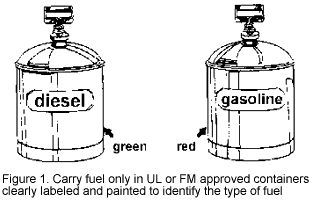Many of us must store some gasoline around our homes to operate lawnmowers, tillers, chainsaws and so on. But if stored improperly, a fire or explosion could result, destroying the house and causing injury or death. Gasoline is a product designed to fuel internal combustion engines. It is a highly volatile liquid, and its vapors can be ignited easily by a spark, flame or other hot object. When mixed with air in the right proportions, the vapor of one cup of gasoline has the explosive power of about five pounds of dynamite, enough destructive force to destroy any house or car.
Of course there are other dangers which can be presented by the improper handling and storage of gasoline and other flammable materials, such as using these materials in the wrong engine or appliance and poisoning. Let's look into some safe ways to handle and store gasoline.
PROPER CONTAINERS
Some plastics become brittle with age and are incompatible with gasoline. Other containers are not strong enough to withstand the pressures of expansion and contraction caused by temperature changes. In addition, some containers sold as gas cans usually cannot be sealed well enough to prevent spilling.
The
best containers for handling  gasoline
are Underwriters Laboratories (UL) or Factory Mutual (FM)
approved safety cans (see Figure 1). Safety cans are available
in several sizes and have various mechanisms for opening the
valve to pour the liquids. Funnel spouts can be added to make
pouring easier and reduce spills. Although the cost is somewhat
more than the cheap cans at the hardware store, they are much
safer and will outlast several of the others. Both UL and
FM have certain requirements which must be met before a safety
can is allowed to carry their approval. The primary features
of safety cans, as required by the testing laboratories, are
listed below:
gasoline
are Underwriters Laboratories (UL) or Factory Mutual (FM)
approved safety cans (see Figure 1). Safety cans are available
in several sizes and have various mechanisms for opening the
valve to pour the liquids. Funnel spouts can be added to make
pouring easier and reduce spills. Although the cost is somewhat
more than the cheap cans at the hardware store, they are much
safer and will outlast several of the others. Both UL and
FM have certain requirements which must be met before a safety
can is allowed to carry their approval. The primary features
of safety cans, as required by the testing laboratories, are
listed below:
Stability: The cans must remain stable when filled and placed on a 30 degree slope.
Leakage: When a filled safety can is inverted, the valve cannot leak more than four drops per minute over a period of five minutes (UL) or 10 minutes (FM). This test must be passed before and after 5,000 (FM) or 10,000 (UL) normal opening/closing operations of the valve. In addition, the seams and joints are examined under pressure for leaks.
Strength: UL tests the body strength with a hydrostatic test of 25 psi. FM tests the strength of the spout and carrying handle by applying loads from 25-125 pounds on the pouring spout, and from 75-250 pounds on the handle, depending on the size of the can.
Fire Exposure: FM places a gas filled safety can in a large flat pan of water on which one inch of fuel is floated and allowed to burn (about eight minutes). The can must vent internal pressure during the fire exposure and retain the contents without spillage.
Flame Arrester: FM checks the flame arrester by passing natural gas through the screen and burning it on the other side. When the gas is shut off, the flame must not flash back through the arrester.
Abuse: FM requires a full can to withstand a three foot drop onto a concrete floor without sufficient damage to cause leakage.
Non Metallic Materials: If the can is not made of metal, additional test requirements must be met. The container must be compatible with various flammable liquids, impermeable to gasoline and it must meet puncture resistance requirements.
HAULING GASOLINE IN VEHICLES
WHEN YOU GET IT HOME
Do not store gasoline in the basement of your home or in the utility room. The furnace, water heater, clothes dryer or any of several other items could ignite fumes which may leak from the can and travel considerable distances. If you do not have a suitable storage area, consider building a cabinet outside your house for storage or purchasing a commercially available flammable liquid storage cabinet, available from safety equipment suppliers. In addition, never put gasoline or any other nonfood material in a container which resembles a food container. Keep gasoline and other dangerous materials locked up. These practices will prevent children from getting to the material and being accidentally poisoned.
Never smoke when handling gasoline and never refuel a hot or running engine. Take a break if you must smoke or let the engine cool down. If fuel is spilled, wipe it up immediately. Before starting the engine, move at least 25 feet away from the fueling area to avoid igniting fuel vapors which are heavier than air and may linger for some time.
Publication #: SP288A
This document is apart of a series from the Agricultural Engineering Department, Agricultural Extension Service, University of Tennessee, Knoxville, Tennessee. Publication date: April 1986.
Timothy G. Prather, Extension Assistant, Agricultural Engineering Department, Agricultural Extension Service, University of Tennessee, Knoxville, Tennessee.
Disclaimer and Reproduction Information: Information in NASD does not represent NIOSH policy. Information included in NASD appears by permission of the author and/or copyright holder. More